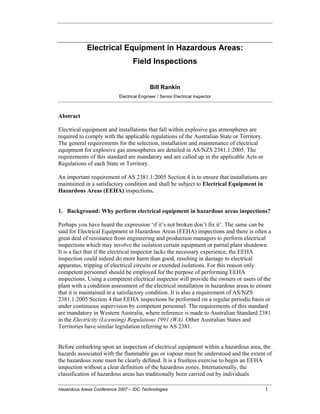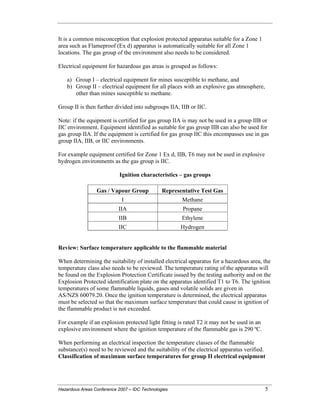Not known Facts About Roar Solutions
Table of ContentsThe Only Guide to Roar SolutionsGetting My Roar Solutions To WorkEverything about Roar Solutions
In such an atmosphere a fire or explosion is possible when three standard conditions are satisfied. This is often referred to as the "hazardous location" or "burning" triangle. In order to shield installations from a prospective explosion a technique of analysing and categorizing a potentially harmful area is needed. The purpose of this is to ensure the appropriate choice and installation of equipment to inevitably prevent a surge and to make sure safety of life.

No equipment must be installed where the surface area temperature of the equipment is greater than the ignition temperature of the offered risk. Below are some usual dust dangerous and their minimum ignition temperature level. Coal Dust 380C 225C Polythene 420C (melts) Methyl Cellulose 420C 320C Starch 460C 435C Flour 490C 340C Sugar 490C 460C Grain Dirt 510C 300C Phenolic Resin 530C > 450C Aluminium 590C > 450C PVC 700C > 450C Residue 810C 570C The chance of the danger existing in a focus high adequate to create an ignition will differ from area to area.
In order to identify this risk an installment is split into areas of danger depending upon the quantity of time the harmful is existing. These locations are described as Areas. For gases and vapours and dirts and fibres there are three zones. Zone 0 Zone 20 A hazardous ambience is extremely most likely to be present and may exist for extended periods of time (> 1000 hours each year) or also continually Zone 1 Zone 21 A dangerous environment is feasible however unlikely to be present for long durations of time (> 10 450 C [842 F] A category of T6 indicates the minimal ignition temperature is > 85 C [185 F] Hazardous location electrical tools possibly created for use in greater ambient temperatures. This would showed on the score plate e.g. EExe II C T3 Ta + 60C( This indicates at 60C ambient T3 will not be exceeded) T1 T1, T2, T3, T4, T5, T6 T2 T2, T3, T4, T5, T6 T3 T3, T4, T5, T6 T4 T4, T5, T6 T5 T5, T6 T6 T6 A T Course score of T1 implies the optimum surface area temperature produced by the tool at 40 C is 450 C. Thinking the associated T Class and Temperature level rating for the equipment are ideal for the location, you can constantly make use of a tool with a much more stringent Department ranking than needed for the location. There isn't a clear answer to this question regrettably. It actually does rely on the sort of devices and what repair services need to be executed. Equipment with particular test procedures that can not be done in the area in order to achieve/maintain third event ranking. Must come back to the manufacturing facility if it is before the devices's solution. Field Repair Service By Authorised Employee: Complicated screening might not be required nonetheless particular treatments might need to be complied with in order for the tools to preserve its third celebration rating. Authorised workers have to be employed to carry out the work appropriately Repair have to be a like for like replacement. New component must be thought about as a straight substitute calling for no special screening of the devices after the repair is complete. Each tool with a hazardous ranking need to be examined independently. These are detailed at a high degree listed below, but also for even more comprehensive details, please refer directly to the guidelines.
Top Guidelines Of Roar Solutions
The tools register is a comprehensive data source of devices records that consists of a minimum set of areas to recognize each item's area, technical parameters, Ex-spouse classification, age, and environmental data. This details is important for tracking and taking care of the equipment efficiently within dangerous locations. On the other hand, for periodic or RBI tasting inspections, the grade will be a mix of In-depth and Close examinations. The proportion of Thorough to Shut inspections will certainly be established by the Tools Risk, which is assessed based upon ignition risk (the probability of a resource of ignition versus the chance of a combustible atmosphere )and the dangerous location category
( Area 0, 1, or 2). This variation will likewise affect the resourcing demands for job preparation. When Great deals are defined, you can establish tasting plans based on the sample dimension of each Whole lot, which refers to the variety of random equipment products to be evaluated. To determine the needed example dimension, two elements require to be reviewed: the size of the Great deal and the classification of assessment, which suggests the level of effort that need to be applied( lowered, typical, or enhanced )to the assessment of the Great deal. By combining the group of inspection with the Great deal size, you can after that establish the ideal denial standards for an example, implying the permitted variety of defective products found within that example. For more information on this process, please refer to the Power Institute Guidelines. The IEC 60079 common advises that the optimum interval between evaluations should not surpass 3 years. EEHA inspections will likewise be carried out beyond RBI campaigns as part of scheduled upkeep and equipment overhauls or fixings. These inspections can be credited towards the RBI example dimensions within the impacted Whole lots. EEHA evaluations are performed to recognize faults in electrical devices. A weighted racking up system is important, as a single piece of devices may have numerous mistakes, each with differing degrees of ignition danger. If the consolidated rating of both evaluations is less than twice the mistake score, the Whole lot is deemed acceptable. If the Great deal is still thought about unacceptable, it should undertake a full evaluation or justification, which may cause stricter assessment methods. Accepted Lot: The sources of any type of faults are determined. If a common failure setting is discovered, extra equipment may need maintenance. Mistakes are identified by seriousness( Safety, Stability, Housekeeping ), making sure that immediate issues are assessed and addressed promptly to reduce any type of influence on security or procedures. The EEHA database must track and tape the lifecycle of mistakes along with the rehabilitative actions taken. Executing a durable Risk-Based Examination( RBI )strategy is vital for making certain conformity and safety in handling Electrical Equipment in Hazardous Locations( EEHA) (Roar Solutions). Automated Fault Scoring and Lifecycle Management: Effortlessly handle mistakes and track their lifecycle to improve assessment accuracy. The introduction of this assistance for risk-based my company inspection further enhances Inspectivity's position as a best-in-class remedy for regulatory conformity, in addition to for any asset-centric assessment usage case. If you are interested in discovering more, we invite you to ask for a demonstration and find exactly how our remedy can transform your EEHA administration processes.
Some Known Incorrect Statements About Roar Solutions

In terms of explosive risk, a hazardous area is an environment in which an eruptive atmosphere exists (or may be expected to be existing) in quantities that need special preventative measures for the building, installment and use of tools. eeha certificate. In this article we check out the challenges faced in the office, the risk control procedures, and the needed expertises to work safely
It issues of modern life that we produce, save or manage an array of gases or liquids that are considered combustible, and a series of dirts that are deemed combustible. These compounds can, in specific conditions, develop eruptive environments and these can have significant and heartbreaking consequences. A lot of us are familiar with the fire triangle eliminate any kind of one of the 3 elements and the fire can not occur, but what does this mean in the context of harmful locations? When damaging this down right into its most basic terms it is essentially: a combination of a specific amount of launch or leakage of a particular compound or material, blending with ambient oxygen, and the presence of a resource of ignition.
In a lot of circumstances, we can do little concerning the degrees of oxygen in the air, yet we can have substantial impact on sources of ignition, for instance electric tools. Unsafe areas are documented on the hazardous location classification illustration and are recognized on-site by the triangular "EX" sign. Here, amongst various other crucial information, areas are divided into 3 kinds relying on the threat, the chance and duration that an eruptive atmosphere will certainly exist; Area 0 or 20 is regarded one of the most hazardous and Area 2 or 22 is considered the least.
Comments on “Roar Solutions - Questions”